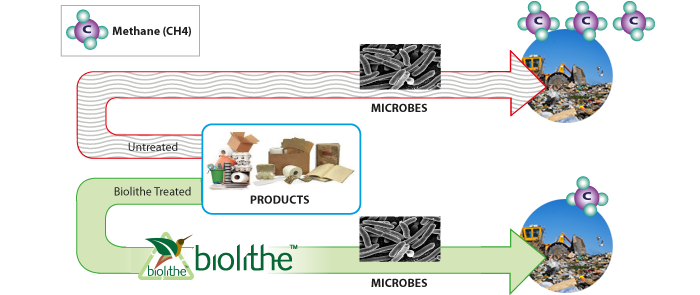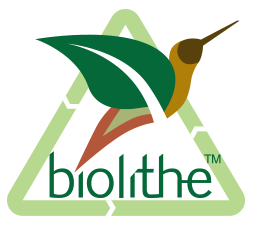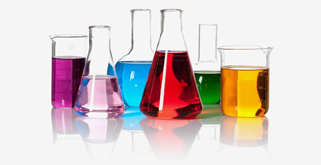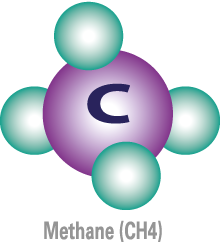How Biolithe Works

We developed Biolithe specifically to address and moderate the environmental impact of paper and paper product waste, which accounts for one-third of the municipal solid waste generated in the U.S. As these materials decompose in landfills, they will – unless properly treated – generate methane, an extremely potent greenhouse gas that traps over 86 times more atmospheric heat than CO2.
Leading the Charge
Biolithe works by effectively prohibiting methane from being produced while continuing to allow paper to breakdown at its normal rate. There is NO OTHER PRODUCT currently on the market that can do what Biolithe does.
A Cellular Battle
Over 60% of the paper and packaging produced in this country each year ends up in landfills, where it immediately start to degrade.
This process occurs because various microbes, including methane-generating methanogens, consume paper's organic compounds in order to generate energy, or in the case of the methanogens, methane gas.
Research has shown that a number of these microbes can generate energy more efficiently than methanogens can, and as long as they have the nutrients they need, will out-compete the methanogens for these compounds, thus reducing their harmful methane output.
Victory
Biolithe, when applied to paper and paper products, works by providing the methanogens' competitors with these essential nutrients, enabling them to beat the methanogens to the table, so to speak. Without access to the organic compounds they need, the methanogens cannot produce their normal level of methane gas. Methane production is severely curtailed before it can even begin.
Applications
Biolithe is a water-based product that is applied to paper and packaging during its production. It is composed of ingredients that are approved in the U.S. for addition to food, food packaging and dietary supplements.
In paper manufacturing, Biolithe is mixed with the starch component during the sizing process, so it is integrated into the paper fibers. Alternately, in packaging applications, it is mixed with the protective aqueous coating that is applied during the final stages of the printing process, prior to the die cutting and folding of the package.
Biolithe Certification Seal
The Biolithe seal will certify products manufactured with Biolithe will play a proactive role in the reduction of methane gas during decomposition and product degradation.

Research
Working closely with scientists at leading universities, our Biolithe, Inc. science team conducted a great deal of thorough and painstaking research during Biolithe's initial development.
Repeated tests proved that the standard strength Biolithe formula strongly inhibits methane from forming in a simulated landfill environment. In these tests, researchers placed strips of paper treated with Biolithe in sealed vials with sludge from a sewage treatment plant. They then compared the results to those from the untreated (baseline) strips to determine Biolithe's effectiveness. They learned that even in low concentrations, Biolithe can still repress methane production.
Ongoing Research
Our science team continues to research and develop new product formulas for specific purposes and determine the best means of applying Biolithe to different products.

All About Methane

The Environmental Protection Agency (EPA) has estimated that municipal solid waste landfills generate approximately 50% methane and 50% carbon dioxide. However, while their amounts may be roughly the same, scientists calculate that methane is at least 23-25 times more potent than carbon dioxide. In 2009, over 600 million tons of methane were released into the atmosphere by the U.S. By the year 2020, scientists project that global methane emissions may increase by 20%.
There is general agreement that methane accounts for up to one-third of the human contribution to global warming. After the methane generated by the enteric fermentation of livestock, our landfills are the next biggest contributor, and may account for 23% of the methane attributable to human actions.
Paper's Role in Methane Production
Despite our move toward a paperless society, the fact is that the production of paper and paper-related products is increasing at ever faster rates, and this paper will eventually make it's way to a landfill.
When paper and other organic waste are deposited into a landfill they start to undergo aerobic decomposition (with oxygen present). As oxygen diminishes within the first year, small amounts of methane are produced. This is referred to as methanogenesis. Afterwards, with anaerobic conditions taking over (no oxygen present), methane production rapidly increases, trapping heat in the atmosphere and creating potentially disastrous greenhouse effects. Methane's greenhouse potency nearly matches that of all of the other non-carbon dioxide gases combined, and compared with carbon dioxide is 23 times more powerful.
Enter Biolithe
There are a variety of ways to redirect paper away from landfills, including recycling, composting, and energy generation projects. However, 100% compliance with these efforts is a lofty and impossible dream, and it is safe to assume that enormous quantities of paper and packaging will continue to wind up in landfills. That's where Biolithe comes in.
